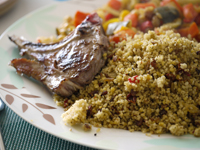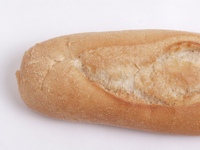Each month we post one recipe by the La Bussola kitchen to this page. If many people ask for it, we may also ask our executive chef to post some recipes that is served at the restaurant. Other than recipes, we will teach you about wine pairing and Italian cuisine in general.
Myrtle Infused Lamb
Serves 4 :
– 8 lamb chops (trim fat and clean bones)
– 12 myrtle branches
– 1/2 cup of water
– 1/2 teaspoon freshly ground black pepper
– 1/4 cup extra-virgin olive oil
– Salt to taste
First, season the chops with salt, pepper, and 2 tablespoons of olive oil. Toss to evenly coat ad then let the chops marinate for 15-20 minutes. Heat your pressure cooker to medium high heat and sear the chops until they’re golden brown. If you don’t have one already you may want to compare pressure cookers and get one to make other recipes. Once the chops are nicely seared, add in the water and myrtle branches. Close and lock the pressure cooker and bring the pot to high pressure. Once you’ve hit high pressure, turn the heat down low and maintain the pressure to cook for 10 minutes. Before serving, drizzle with some olive oil and heat on the grill to get added flavor. Be careful not to leave the lamb chops on for too long or else they will fall apart on the grill. Only grill the chops long enough to get a quick char. Serve with your choice of vegetables or sides.
More on pressure cookers: After introducing this recipe we’ve been asked by many people how they can use a pressure cooker. Basically, anything that you cook in a pot can be cooked in a pressure cooker for less than half the time. You can cook stews, soups, meat, vegetables, risotto, rice, and much more. If you are new to pressure cookers and think they sound intimidating to use, they’re actually very simple. Think about it, even La Bussola’s grandmama uses it! Some of you also asked us about some tips on buying one but we’re not experts, so we encourage you to check out the best pressure cooker ratings on Cookwithpressure.com instead.
Traditional Italian Bread

The most amazing Italian breads have a soft but firm crust, and sturdy but moist interior. Many people confuse it for French bread, but the main difference is Italian bread tends to have more infused flavors while French bread is more simple and lean. There are also many more varieties of Italian breads (focaccia, pane siciliano, ciabatta, panettone, panmarino, grissini, casiatiello, etc.) than French breads. The differences don’t stop there. Bread, like many other foods, vary by region and there are many overlapping qualities. But most people prefer to make French breads like baguette because they go well with a lot of food and are much simpler to make. In fact, nowadays, the best bread making machine is equipped with a program that specifically makes French bread. Here is a recipe to make a traditional ciabatta loaf. Ciabatta is typically used to make panini.
Biga (pre-fermentation):
– 1/4 tsp dry yeast
– 1 cup of warm water
– 1 1/4 cup of all-purpose flour
Bread:
– 1 tsp dry yeast
– 3 tbsp of milk at room temperature
– 2/3 cup of warm water
– 1 tbsp of olive oil
– 2 1/3 cup of all-purpose flour
– 1 ½ tsp of sea salt
– cornmeal for baking tray
First you have to prepare the biga the day before baking. Combine yeast and water, then slowly mix in the flour and stir so that all the lumps dissolve into the mixture. It will be very sticky and wet. Once combined, cover it then refrigerate for at least 12 hours. Then to make the bread, stir yeast and milk first, then add water, oil, and one cup of the biga. To do this, you can use a stand mixer. If you read Panasonic bread machine reviews, it’s also possible to use the machine only as a mixer too. After everything is combined, the next step is kneading. You can do this by hand or stand mixer using the dough hook. Or if you use the bread machine, the process automatically kicks in. Knead for 5 minutes in total, being careful not to over-knead. It should feel stretchy and springy. Then place the dough into an oiled bowl. Cover and let it sit for 90 minutes. After it rises, the dough will have large air bubbles. Then place the dough onto a floured surface to roll up into the shape of a bread. Cut into two if needed, then place on a baking tray that is already lined with parchment paper sprinkled with cornmeal. Cover again and let it rise for another 90 minutes. Preheat your oven at 425 degree F and heat a baking tray. Spray the bread with a bit of water. Take the parchment paper with the bread and transfer it carefully onto the hot tray. Bake for 10 minutes, spray bread with water, and bake for another 10-15 minutes until done. Allow the bread to rest before slicing.